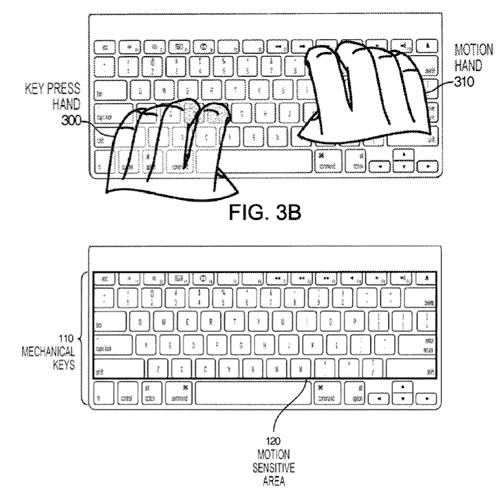Apple's patent applications have always been a topic of interest here at MacRumors. They give us a rare look into Apple's research and development labs, although many of the concepts never see the light of day.
For years, we've seen Apple patent applications for touch-sensitive keyboards. Those patents have been based on the pioneering work of FingerWorks, a company which was acquired by Apple in 2005 and served as the basis for much of Apple's multi-touch technology. Prior to the acquisition, FingerWorks had produced several touch-sensitive multi-touch keyboards that garnered positive reviews, although they never became mainstream products. The one major hurdle in the adoption of these touch-only keyboards has been the lack of tactile feedback as compared to traditional keyboards.
A new Apple patent application that we've uncovered seems, however, to try to address that issue by creating a hybrid physical keyboard that will also double as a motion-sensitive input device. The patent application is authored by John Elias, one of the co-founders of FingerWorks.

First, Apple acknowledges that the physical keyboard remains the preferred input device:
For years, we've seen Apple patent applications for touch-sensitive keyboards. Those patents have been based on the pioneering work of FingerWorks, a company which was acquired by Apple in 2005 and served as the basis for much of Apple's multi-touch technology. Prior to the acquisition, FingerWorks had produced several touch-sensitive multi-touch keyboards that garnered positive reviews, although they never became mainstream products. The one major hurdle in the adoption of these touch-only keyboards has been the lack of tactile feedback as compared to traditional keyboards.
A new Apple patent application that we've uncovered seems, however, to try to address that issue by creating a hybrid physical keyboard that will also double as a motion-sensitive input device. The patent application is authored by John Elias, one of the co-founders of FingerWorks.

First, Apple acknowledges that the physical keyboard remains the preferred input device:
Over the last forty years there have been numerous attempts made to introduce an alternative to the standard keyboard. The changes include, but are not limited to, non-QWERTY layouts, concave and convex surfaces, capacitive keys, split designs, membrane keys, etc. However, although such alternative keyboards may provide improved usability or ergonomics, they have failed to replace or duplicate the commercial success of the conventional mechanical keyboard.
More Here
Courtesy:http://www.macrumors.com/
{ 0 comments... read them below or add one }
Post a Comment